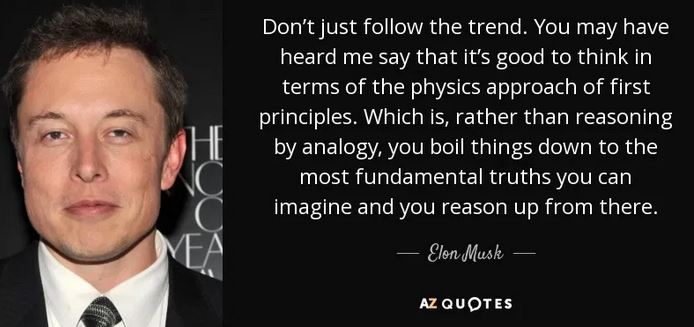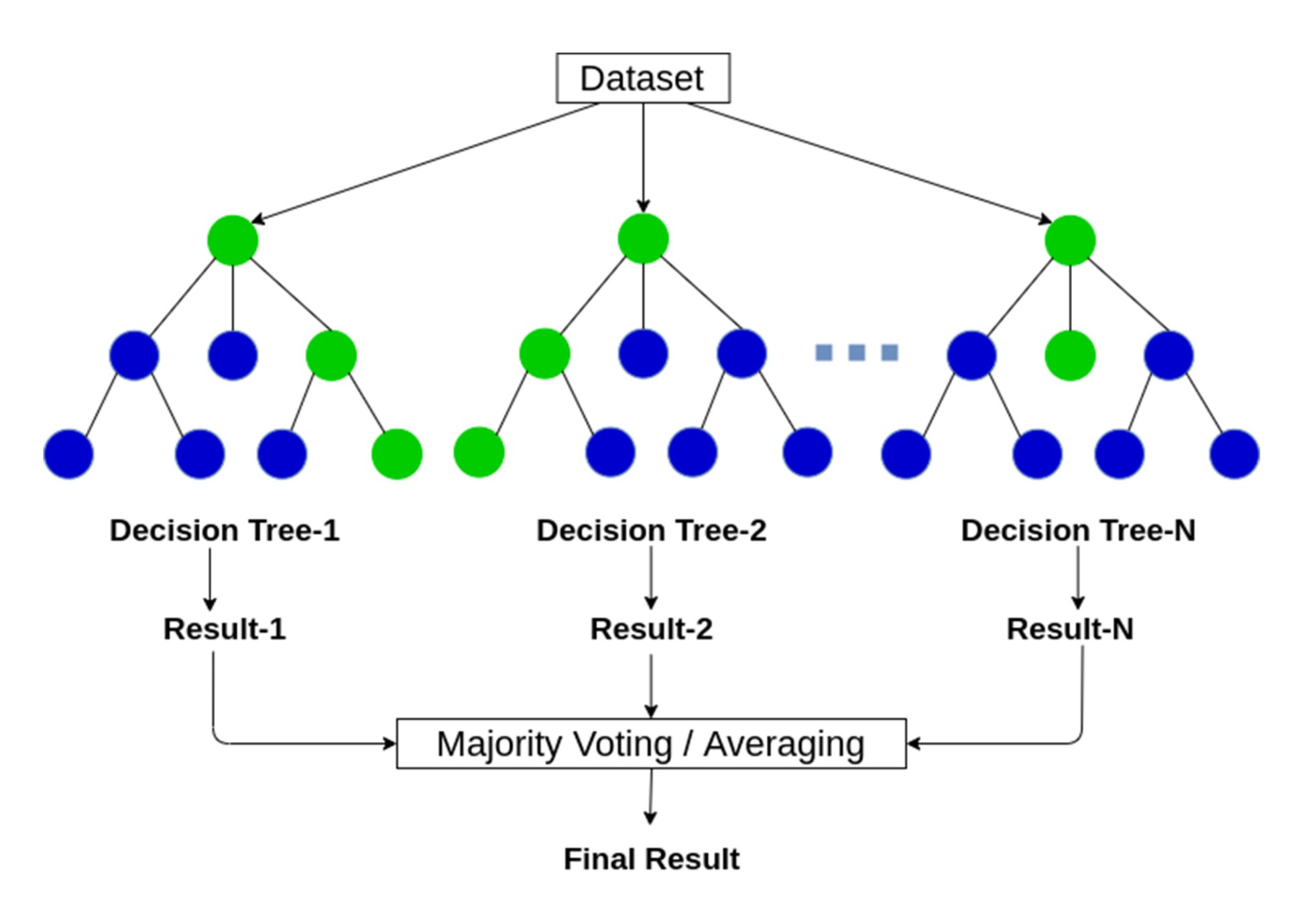Leadership models III: First Principles Thinking
Marton Trencseni - Tue 16 May 2023 - Leadership
Introduction
This is the third article in my series on useful mental models in leadership and self-management:
- Leadership models I: Iceberg Model, Six Thinking Hats, Trust Equation, Circle of influence, OODA Loop
- Leadership models II: Growth Mindset, Eisenhower Matrix, Tuckman Model, Cynefin Framework, SCARF Model
I dedicate a full post to First Principles Thinking, popularized by Elon Musk, CEO of SpaceX and Tesla, who has credited First Principles Thinking as a key factor in his ability to create innovative solutions and businesses. He contrasts it with reasoning by analogy, or taking what's already given and making incremental improvements.
First Principles Thinking
First Principles Thinking is a problem-solving method that involves breaking down complex problems into their most basic, fundamental elements and then reasoning up from there. The idea is to shed assumptions and received wisdom in order to understand the foundational principles at the heart of the problem:
- Identify and Define Your Assumptions: Start by identifying what you think you know about a given problem or situation. These are your assumptions or beliefs that may or may not be true.
- Break Down the Problem into Its Fundamental Principles: Once you have identified your assumptions, start breaking down the problem into its basic, fundamental parts. These are the truths or principles that are so fundamental that they cannot be broken down further.
- Create New Solutions from Scratch: Using these fundamental principles, start to build up a solution from scratch. This is where the innovative solutions can come from, as you're no longer constrained by existing methods or conventional wisdom.
For example, when Elon Musk was faced with the high cost of space travel, he didn't just accept the established "fact" that rockets are expensive. Instead, he broke the problem down to its first principles, asking why a rocket is expensive and what materials make up a rocket. He discovered that the materials cost of a rocket was about 2% of the typical price. This insight led him to the idea of building cost-effective rockets, a key factor in SpaceX's success.

First Principles Thinking can be challenging as it forces you to abandon preconceived ideas and assumptions. However, it can also lead to innovative solutions that would have been missed with traditional problem-solving methods.
Below are illustrations of First Principles thinking: - SpaceX and Elon Musk - Berkshire and Warren Buffet - Google's organization design - Python - Random Forests - Convolutional Neural Networks
SpaceX
One of the most well-known examples of First Principles Thinking applied by Elon Musk is his approach to building reusable rockets at SpaceX.
Traditionally, rockets have been single-use. After delivering their payload, they either burn up in the Earth's atmosphere or fall back to Earth and land in the ocean, rendering them unusable for future launches. This method was considered a "given" in the industry. It contributed significantly to the high cost of space travel, as a new rocket had to be built for every launch.
Musk, however, didn't accept this as a given. Instead, he applied First Principles Thinking. He started by questioning the fundamental premise: Why are rockets single-use? Is it a fundamental law of physics that they have to be? It turned out that it wasn't.
Next, he broke down the cost of a rocket into its fundamental principles. He found that the raw materials that make up a rocket only account for about 2% of the final cost of a rocket. This meant that the significant cost was coming from the manufacturing and assembly of these materials into a rocket. If a rocket could be reused, then the cost per launch could be dramatically reduced.
From these first principles, Musk and his team at SpaceX began developing rockets that can return to Earth and land vertically, allowing them to be reused for future launches. Despite significant skepticism and several early failures, SpaceX has successfully landed multiple rockets back on Earth and reused them, significantly reducing the cost of each individual launch and revolutionizing the space industry in the process. This example illustrates how First Principles Thinking can challenge established norms and lead to innovative solutions, even in industries that have been operating the same way for decades.
Berkshire
Warren Buffet and Charlie Munger, the leaders of Berkshire Hathaway, are well known for their application of First Principles Thinking in their investment strategies. They have developed a distinctive approach to investing, which involves careful analysis of a company's fundamentals rather than following market trends or short-term fluctuations.
A fundamental principle of their investing philosophy is the concept of "intrinsic value". Instead of focusing on external factors like market sentiment or speculative trends, they look at the underlying value of a business. They assess factors such as the company's earnings, the quality of its management, its competitive position, and its potential for growth. If the market price of a company is significantly below its intrinsic value, they see it as a good investment opportunity.
This approach requires deep understanding and analysis of a business – its operations, its industry, its competitors, and its risks. This is in contrast to some other investment approaches that focus more on technical analysis of stock price movements or macroeconomic trends.
Another example of their First Principles Thinking is their focus on "circle of competence". They believe in investing only in businesses that they understand thoroughly. This means they often avoid hot trends or sectors they are not familiar with, even if these are popular with other investors.

Their First Principles approach to investing has helped Buffet and Munger achieve consistent returns over the long term and build Berkshire Hathaway into one of the largest and most successful investment companies in the world. Their success shows how First Principles Thinking can lead to superior results, even in fields like investing where there is a lot of uncertainty and many different approaches can be successful.
Google's unique approach to organizational design and management can be seen as an application of First Principles Thinking. Instead of accepting traditional management structures and practices as given, they questioned the fundamental principles of how to organize and manage a company for innovation and productivity.
- 20% time policy: traditionally, companies expect employees to dedicate 100% of their work time to their assigned tasks and projects. Google, however, applied First Principles Thinking to this issue. They started with the premise that creative and innovative ideas can come from anyone in the organization, and that employees may have interests and abilities that aren't being used in their regular work. From this, they developed the "20% Time" policy, which allows engineers to spend 20% of their time working on any project they choose. The idea is that by giving employees time and freedom to explore their own ideas, they can foster innovation and creativity. This policy has led to the development of some of Google's most successful products, including Gmail, Google News, and AdSense.
- Hiring and team formation: Instead of simply looking at a candidate's credentials and experience, Google looks at attributes like problem-solving ability, conscientiousness, and comfort with ambiguity. They recognize that the challenges they face are often unique and require innovative thinking, so they value these qualities over specific experience or expertise. They also pay attention to team dynamics, understanding that the success of a team depends not just on the skills of its members, but on their ability to work together effectively.
- Objective and Key Results (OKRs): Google has adopted and popularized the use of OKRs, a goal-setting system that requires every team and individual in the company to set ambitious goals and measurable key results each quarter. The OKRs are publicly available to all employees in the organization. This practice promotes transparency, alignment, and focus throughout the organization, ensuring everyone is working towards the same strategic objectives. The public nature of OKRs also fosters a culture of accountability and open communication. Rather than accepting traditional goal-setting or performance management systems, Google's use of OKRs reflects a First Principles approach to driving organizational performance.
- Flattened Hierarchy and Openness: Google has questioned the traditional hierarchical structure found in many organizations. Instead of a rigid hierarchy, Google promotes a more flattened organizational structure, where the distance between executives and employees is minimized. This is evident in practices such as 'TGIF' meetings (now called 'TGiT' since they moved to Thursdays), where founders Larry Page and Sergey Brin, and later Sundar Pichai, held weekly all-hands meetings where they shared updates and fielded questions - both in person and submitted online - from Googlers around the world. This level of transparency and open communication is unusual in large corporations but reflects Google's First Principles approach to leadership and management.
- Focus on Data: Google is known for its data-driven decision-making culture. They apply First Principles Thinking in this area by challenging the idea that business decisions are best made based on experience or intuition. Instead, they argue that decisions should be based on data and rigorous analysis. This can be seen in their "People Analytics" function, which applies data analysis methods to HR and management issues. For example, they used data analysis to develop their "Project Oxygen", where they identified the key behaviors of effective managers at Google, challenging preconceived notions of what makes a good manager.

These examples illustrate how Google applies First Principles Thinking to various aspects of its organizational design and management practices, questioning traditional assumptions and developing innovative, effective practices based on fundamental principles.
Python
Python was created in the late 1980s by Guido van Rossum. At the time, many programming languages were designed with a focus on machine efficiency, resulting in code that could be difficult to write and even more difficult to read. Syntax was often complex and verbose, and different tasks could require vastly different conventions or paradigms. This made many languages difficult to learn and code difficult to maintain.
Rather than accepting these characteristics as a given, van Rossum took a First Principles approach when designing Python. He started with the premise that code is read more often than it is written, and therefore readability counts. This led to a focus on simplicity and clarity in Python's design. Python's syntax is straightforward and consistent, making it easier to read, write, and learn than many other languages.
Another first principle was that there should be one, and preferably only one, obvious way to do it. This contrasts with languages like Perl, which proudly proclaims that there is more than one way to do it. This principle guided the design of Python's features and syntax, resulting in a language where different programmers will often write very similar code to perform the same task, which greatly aids readability and maintainability.
These principles have guided Python's development for over three decades, and have helped it become one of the most popular programming languages in the world. This demonstrates how First Principles Thinking can be applied to software design, leading to innovative solutions that challenge the status quo.
Random Forests
Before the development of ensemble methods like Random Forest, decision trees were a popular method for both classification and regression tasks. They were easy to understand and interpret, but they often suffered from high variance, meaning that they were prone to overfitting the training data and performed poorly on unseen data.
Instead of trying to tweak or adjust decision trees to make them more robust, Leo Breiman, the inventor of the Random Forest algorithm, went back to the first principles. He realized that the high variance was a fundamental issue with decision trees, and that the solution was not to fix individual trees but to change the way they were used.
This led him to the concept of bagging (bootstrap aggregating), where multiple decision trees are trained on different subsets of the data, and their predictions are aggregated to produce a final result. This approach effectively reduces the variance without increasing the bias, making the model more robust and reliable.
Random Forests added another layer to this concept: feature randomness. In addition to training each tree on a different subset of the data, Random Forests also use a subset of features at each split in the decision tree. This further increases the diversity of the individual trees in the forest, making the model even more robust.

The development of Random Forests has had a significant impact on the field of machine learning. They are one of the most powerful and widely used machine learning algorithms today, and their development has inspired a range of other ensemble methods. This shows how First Principles Thinking can lead to major breakthroughs and innovations.
Convolutional Neural Networks
First Principles Thinking in data science, machine learning, and AI involves starting from foundational truths about data and algorithms and building up from there. This can lead to more effective models and methods of analysis. Consider the development of convolutional neural networks (CNNs) for image recognition as an example.
In the early days of AI and machine learning, image recognition was a significant challenge. Traditional algorithms struggled with changes in orientation, size, and lighting conditions in images. The common approach was to engineer features manually, which was very time-consuming and not particularly effective.
Instead of trying to incrementally improve these methods, researchers applied First Principles Thinking. They started by considering the fundamental nature of the problem: recognizing patterns in pixel data that are invariant to scale, orientation, and other transformations.
Researchers, notably Yann LeCun and his team, drew inspiration from the human visual system, where different neurons specialize in recognizing different patterns and these patterns are combined to understand the whole image. This led them to design a completely new kind of neural network architecture, the Convolutional Neural Network, which incorporates convolutional layers that can automatically learn a variety of spatial hierarchies of features, effectively learning from the fundamental features of the image data.

The convolutional layer uses a set of learnable filters. Each filter is spatially small but extends through the full depth of the input volume. During the forward pass, each filter is convolved across the width and height of the input volume, computing the dot product between the entries of the filter and the input and producing a 2-dimensional activation map of that filter. As a result, the network learns filters that activate when they see some type of visual feature such as an edge of some orientation or a blotch of some color on the first layer.
CNNs revolutionized the field of image recognition and now form the basis for most image recognition technology, including facial recognition and self-driving cars. This is a great example of how First Principles Thinking can lead to significant breakthroughs in technology and AI.
Conclusion
First Principles Thinking is a problem-solving approach that involves breaking down complex problems into their fundamental, self-evident truths and then reasoning up from these base truths to create new understanding or solutions. This method encourages innovative thinking by challenging existing assumptions and conventions, and building new solutions from the ground up.